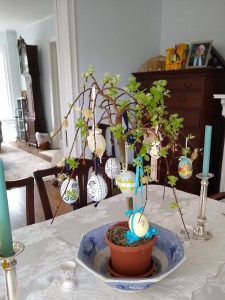 When I go outside in spring, I look for the signs of hope that are symbolic of the season. The other day I saw an inspiring one–a Japanese cherry tree in full bloom. Its bark had the deepening furrows that develop as trees age, much like human wrinkles. The clouds of overhead blooms were lovely, but the tree’s most heartening production was a single, six-inch root sucker at the base. The little sprout was making its own spring show, with a brave puff of white flowers and nascent green leaves. It was an old tree’s leap towards new life.
When I go outside in spring, I look for the signs of hope that are symbolic of the season. The other day I saw an inspiring one–a Japanese cherry tree in full bloom. Its bark had the deepening furrows that develop as trees age, much like human wrinkles. The clouds of overhead blooms were lovely, but the tree’s most heartening production was a single, six-inch root sucker at the base. The little sprout was making its own spring show, with a brave puff of white flowers and nascent green leaves. It was an old tree’s leap towards new life.
New life is also flourishing on my dining room table, in the form of a small, weeping
pussy willow tree, known more formally as Salix caprea ‘Pendula’. The species is also known as “goat willow”, from the same Latin root that gives us the name of the constellation Capricorn.
I am not sure about the goat association, but in milder climates than mine, the catkins may appear at the end of winter. This would coincide with the final days of the astrological sign, Capricorn, which runs from December 21 through January 20. Some sources also suggest that the fast-growing, readily self-renewing plant was used in its native Eurasia as a “browse” or fodder for goats. Though less poetic, it may be a more likely explanation for the name.
Right now, my domestic “goat” is about 30 inches tall. When it arrived two weeks ago, the slender, arching branches sported the soft, dove-gray catkins that give the willow its best known common name. Now, the catkins are falling off, clearing the way for fresh, narrow green leaves.
My daughter spotted the potted tree in front of a florist’s shop the week before Easter. She decided to bring it home because she knew that while I have always loved pussy willows, I have never gotten around to buying one. We used it as an egg tree, hanging decorated eggs and egg-shaped ornaments from the branches. Soon, the decorations will go back into storage and the little tree will go out to its new home in the back garden.
Florists’ plant labels are designed to attract potential buyers by providing a few details about the individual specimen’s basic needs. The labels generally leave out certain other details that might scare those buyers away. This is why information about mature size is usually missing. When my daughter brought home our “goat”, she had no idea what size animal we would end up with. Fortunately horticultural reference sources are plentiful, and it was easy to find out that our grafted specimen had the potential to develop into a small tree, rising to about ten feet tall, with a spread of up to six feet.
I hope to keep it a bit smaller, perhaps by growing it in a large container and/or pruning it regularly. I follow this practice with its relative, the coral bark willow, which grows in my front border. The results are excellent, except at times when my good intentions are eclipsed by the realities of other personal and professional responsibilities.
Various gardening guides suggest that my Salix caprea is deer resistant and tolerant of wet soil and the roots black walnut trees. The varmint resistance will not please Mr. Antlers and his harem, who are regular denizens of my property, but it will save on deer spray. I appreciate the tree’s toughness, even though black walnut is not a worry in my neighborhood and the soil is usually moist enough to sustain life, but never swampy.
Goat willows are dioecious, which means that trees are either male or female. The male specimens bear larger catkins, so I presume that a florist’s plant would be male. Again, the plant tag makes no mention of this, so I cannot be completely sure.
My little goat willow is a personal celebration of all the newness that the season brings. After the physical and psychological storms that we have all endured over the past year, it puts me in mind of the wonderful song, “It’s a New Day”, made famous by singer Nina Simone.
 If you need the same kind of personal celebration, you can buy Salix caprea at large garden centers or, sometimes, big-box stores. It is occasionally sold under the varietal name, ‘Kilmarnock’, after a specimen that was discovered in Kilmarnock, Scotland, in the mid nineteenth century. To be sure of buying a tree-form or standard variety, make sure it is a grafted plant.
If you need the same kind of personal celebration, you can buy Salix caprea at large garden centers or, sometimes, big-box stores. It is occasionally sold under the varietal name, ‘Kilmarnock’, after a specimen that was discovered in Kilmarnock, Scotland, in the mid nineteenth century. To be sure of buying a tree-form or standard variety, make sure it is a grafted plant.
